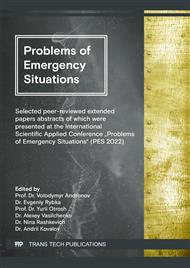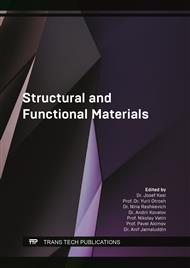[1]
L.V. Lyashok, B.I. Bayrachnyy, I.A. Tokareva [i dr.], Kompleksnaya pererabotka tekhnogennykh otkhodov vol'frama. Energotekhnologii i resursosberezheniye, 1 (2012) 43–46. [in Russian].
Google Scholar
[2]
B.I. Bayrachnyy, L.V. Lyashok, Tekhnichna elektrokhimiya: pidruchnyk. (CH. 4). Hidroelektrometalurhiya. Kharkiv: NTU «KHPI», 2012. [in Ukrainian].
Google Scholar
[3]
Yu.M. Korolev, T.Sh. Agnokov, M.F. Sviderskiy i dr. Ftoridnaya skhema pererabotki metallicheskikh otkhodov vol'frama i molibdena. Khimiya i tekhnologiya molibdena i vol'frama. (s. 26–34). Nal'chik, 1983. [in Russian].
Google Scholar
[4]
S.S. Deyneka, G.N. Zviadadze, Khloridnaya pererabotka vtorichnogo syr'ya vol'frama. Tsvetnyye metally, 9 (1984) 65–68. [in Russian].
Google Scholar
[5]
Xingbo Yang, Jie Xiong, Toshinari Sumi, US Patent No 20110048968A1. 2011. Recycling tungsten carbide.
Google Scholar
[6]
V.R. Ivashkiv, Teoretychni osnovy i tekhnolohichni zasady elektrokhimichnoho pereroblennya psevdosplavu WC–Ni. (Dys. kand.tekh.nauk). Kharkiv, 2016. [in Ukrainian].
Google Scholar
[7]
V.N. Zaichenko, S.S. Fomanyuk, Yu.S. Krasnov, Recovery of tungsten and cobalt from secondary raw materials by a combined electrochemical and chemical procedure. Russian J. Applied Chem, 83 (9) (2010) 1660–1662.
DOI: 10.1134/s1070427210090284
Google Scholar
[8]
G.A. Kolobov, S.A. Vodennikov, V.V. Pavlov [ta ín.], Pererabotka otkhodov vol'fram– i molibdensoderzhashchikh staley i slozhnolegirovannykh splavov. Metalurgíya, 1 (35). (2016) 19–23. [in Russian].
Google Scholar
[9]
A.A. Palant, V.A. Pavlovskiy, Fiziko–khimicheskiye i tekhnologicheskiye osnovy elektrokhimicheskoy pererabotki otkhodov metallicheskogo vol'frama. Tekhnol. Met, 11 (2003) 3–7. [in Russian].
Google Scholar
[10]
P.K. Katiyar, N.C. Randhava, J. Hait et al. Anodic dissolution behavior of tungsten carbide scraps in ammoniacal media. Advanced materials research, 828 (2014) 11–20.
DOI: 10.4028/www.scientific.net/amr.828.11
Google Scholar
[11]
A.I. Dikusar, I.A. Ivanenko, B.P. Saushkin [i dr.], Vysokoskorostnoye anodnoye rastvoreniye zharoprochnykh khromonikelevykh splavov, soderzhashchikh vol'fram i reniy. Elektricheskaya razmernaya obrabotka materialov, 43 (4) (2007) 4–11. [in Russian].
Google Scholar
[12]
V.V. Malyshev, S.A. Butusov, Razdeleniye kobal'ta i karbida vol'frama anodnym rastvoreniyem tverdykh splavov v rastvorakh fosfornoy kisloty. Zhurnal prikladnoy khimii, 76 (3) (2003) 398–401. [in Russian].
Google Scholar
[13]
R. Morales, R. E. Aune, S. Seetharaman, O. Grinder, The powder metallurgy processing of refractory metals and alloys. Journal of the Minerals, Metals and Materials Society, 55 (10) (2003) 20–23.
DOI: 10.1007/s11837-003-0169-9
Google Scholar
[14]
G.G. Tul'skij, L.V. Liashok, M.P. Osmanova and I.N. Kjlupaev. Electrochemical Production of Tungsten Powders from Tungsten Hardmetal Waste. Powder Metallurgy and Metal Ceramics, 58 (9-10) (2020) 499–502.
DOI: 10.1007/s11106-020-00102-3
Google Scholar
[15]
Kolupaev I., O. Sobol, A study of initial stages for formation of carbon condensates on copper. Eastern-european journal of enterprise technologies, 4/12 ( 94 ) (2018) 49–55.
DOI: 10.15587/1729-4061.2018.140970
Google Scholar
[16]
G.G. Tul'skij, L.V. Lyashok, I.M. Kolupaev, M.P. Osmanova. Ukrainian utility model patent UA No. 149278 U. 2021. The method of obtaining heat-resistant aramid fiber.
Google Scholar
[17]
O.G. Zarubitskiy, V.P. Orel, B.F. Dmitruk, Pirokhimicheskaya tekhnologiya pererabotki vol'fram– i kobal't–soderzhashchego syr'ya. Zhurnal prikladnoy khimii, 77 (11) (2004) 1761–1763. [in Russian].
Google Scholar
[18]
T. Angerer, S. Luidold, H. Antrekowitsch, Technologien zum Recycling von Hartmetallschrotten. Tell. 3. Erzmetall, 64 (6) (2011) 328.
Google Scholar
[19]
C. Edtmaier, R. Schiesser, C. Meissl etc. Selective removal of the cobalt binder in WC/Co based hardmetal scraps by acetic acid leaching. Hydrometallurgy, 76 (1–2) (2005) 63–71.
DOI: 10.1016/j.hydromet.2004.09.002
Google Scholar



